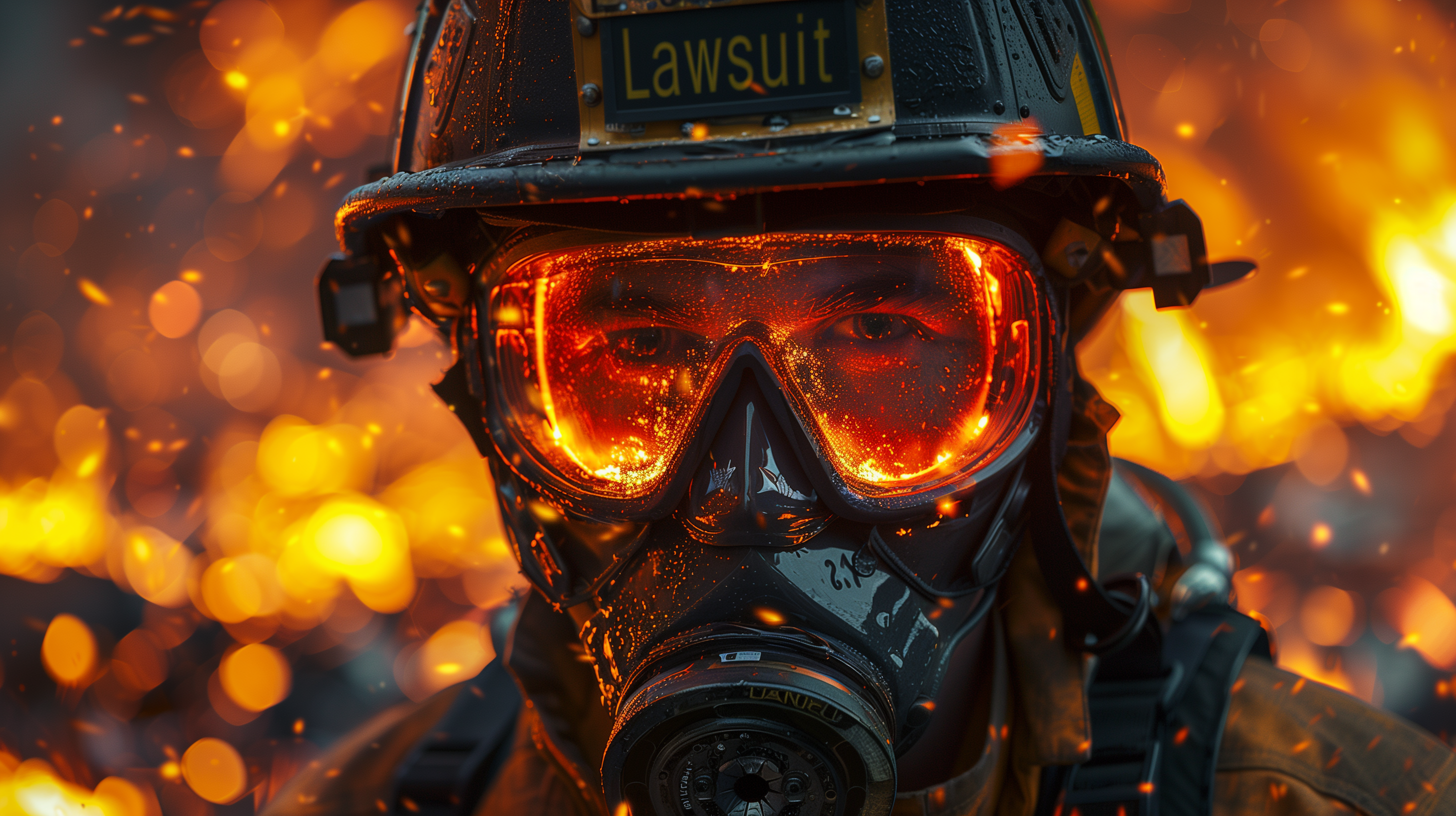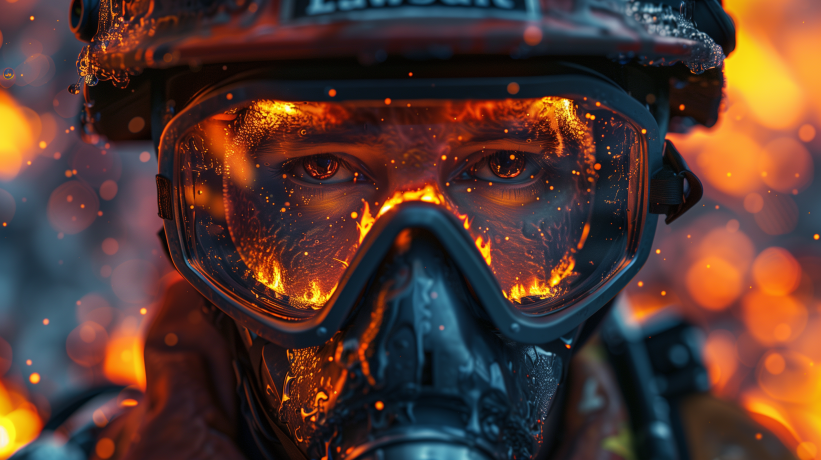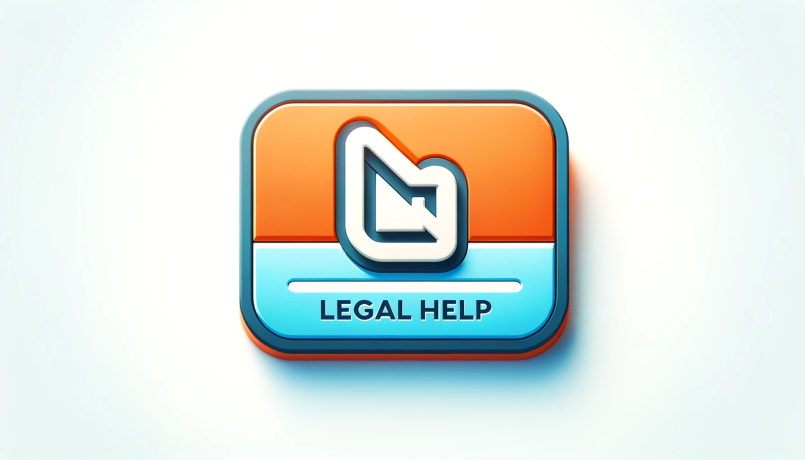
A devastating natural gas truck explosion in Los Angeles has led to a lawsuit by seven injured LAFD firefighters. The incident highlights the dangers faced by first responders and raises critical questions about the safety of compressed natural gas vehicles on our roads.
by LawInc Staff
June 23, 2024
On February 15, 2024, seven Los Angeles Fire Department (LAFD) firefighters suffered severe injuries when a compressed natural gas (CNG) tank exploded while they were battling a commercial truck fire in Wilmington, a neighborhood in the Harbor area of Los Angeles.
The firefighters have filed a lawsuit against the truck and CNG tank manufacturers, alleging the explosion was caused by defective design, manufacture, and inadequate warnings. They further claim that the companies that owned and operated the truck were negligent in its maintenance and operation.
This guide breaks down the key facts, parties, legal issues, and potential arguments on both sides. You’ll gain a thorough understanding of the lawsuit and the product liability and negligence laws at the heart of the firefighters’ claims.
From the strict liability allegations against the CNG tank makers to the negligent training and maintenance claims against the trucking firms to the potential defenses the companies may raise, get the detailed information and expert insight you need to follow this high-stakes case.
1. Understand the Basic Facts of the Case
-
- The Incident: On Feb. 15, 2024, LAFD firefighters responded to a commercial truck fire on the 1100 block of N. Alameda St. in Wilmington. While fighting the fully engulfed fire, one of the truck’s two CNG tanks suddenly exploded “like a bomb,” severely injuring seven firefighters on scene.
- The Plaintiffs: Injured firefighters Andres Saenz II, Casey Dunn, Daniel Goen, Howard Weiserweaver, Ian Gallardo, Robert Ward, and Tom Rodriguez filed suit. They allege the “massive shock wave” from the exploding tank caused them “agonizing” and “life-altering injuries.”
- The Defendants: The firefighters sued the CNG tank manufacturers (Hexagon Agility, Agility Fuel Solutions, Agility Fuel Systems), the truck manufacturer (Daimler Truck North America), and the companies that owned, operated and maintained the truck (Heavy Load Transfer, Total Transportation Services, Premium Transportation Services).
- The Allegations: The complaint asserts causes of action for negligence, strict products liability (design defect, manufacturing defect, warning defect), and breach of warranty. Plaintiffs allege the CNG tank was “defective” and “unreasonably dangerous” and that defendants failed to warn of risks.
- The Damages: The firefighters seek compensatory damages for past and future medical expenses, lost earnings, pain and suffering, and emotional distress. They claim the CNG tank explosion caused severe, permanent and disabling injuries.
Behind the Scenes:
-
- CNG is increasingly being adopted as a “cleaner” alternative fuel for commercial trucks, touted for its lower emissions compared to diesel. However, the transition has not been without growing pains, as the unique hazards posed by CNG remain a challenge for firefighters, regulators, and the industry alike.
- High-pressure CNG tanks, like the one that ruptured in this incident, can essentially become devastating fragmentation bombs when exposed to intense heat and flames. This risk necessitates specialized firefighting tactics, safety protocols, and equipment to mitigate the potential for catastrophic failure.
- In response to these concerns, industry groups such as the Natural Gas Vehicles for America (NGVA) association have developed training programs for first responders on the safe handling of CNG incidents. These programs aim to educate firefighters on the specific characteristics of CNG fires, appropriate suppression techniques, and the critical importance of maintaining a safe distance from the tanks.
- With few legal precedents involving exploding CNG tanks and firefighter injuries, the outcome of this case could have far-reaching implications. The court’s decision could set significant legal standards for liability in similar future incidents, potentially impacting the design, manufacture, and maintenance of CNG systems in commercial vehicles, as well as emergency response protocols and training for firefighters.
- The case could also raise questions about the adequacy of current safety regulations and the responsibility of manufacturers and operators to go beyond minimum requirements to ensure public safety.
Legal Analysis:
-
- Plaintiffs will need to prove the specific defects that made the CNG tank “unreasonably dangerous” and link those defects to their injuries to establish strict liability.
- Negligence claims require showing the defendants failed to use reasonable care in making, equipping, maintaining or operating the tank and truck.
- Causation will be key – plaintiffs must demonstrate the explosion and their injuries wouldn’t have occurred but for the alleged defects and negligence.
- Defendants may argue firefighters assumed the risk given the inherent dangers of the job, but CA law is unsettled on applying that defense to products liability.
- Apportioning fault among the tank makers, truck manufacturer and operators will be complex if evidence shows multiple issues combined to cause the explosion.
FAQs:
-
- How common are CNG tank explosions during vehicle fires? While exact statistics are difficult to find, data from the National Fire Protection Association (NFPA) shows that approximately 1,000 CNG vehicle fires occur annually in the United States. While tank explosions are a potential risk, they are not a common occurrence in CNG vehicle fires. However, even rare instances of explosions can have devastating consequences, highlighting the importance of safety measures and proper handling of CNG equipment.
- What makes a product “unreasonably dangerous” under strict liability laws? It must have a defect (design, manufacturing or warning) that presents a substantial danger beyond what an ordinary consumer would expect.
- How might the firefighter’s employment affect their case? As on-duty firefighters covered by CA workers’ comp, they generally can’t sue their employer but can bring claims against third-party defendants.
- What type of evidence will be key to proving the defect allegations? Expert analysis of the remains of the exploded tank, review of design plans/manufacturing records, and testimony from engineers on industry standards.
- How long could a complex case like this take to resolve? Large multi-party products liability and negligence lawsuits often take years to litigate, but pre-trial settlements are also common.
2. A Deeper Look at the Parties Involved & Accident Facts
-
- Plaintiffs: Seven LA City firefighters injured in the explosion: Andres Saenz II, Casey Dunn, Daniel Goen, Howard Weiserweaver, Ian Gallardo, Robert Ward, Tom Rodriguez
- CNG Tank Defendants: Hexagon Agility Inc, Agility Fuel Solutions LLC, Agility Fuel Systems LLC (manufacturers & sellers of the CNG tank)
- Truck Manufacturer Defendant: Daimler Truck North America LLC (manufacturer of Freightliner semi-truck)
- Truck Owner/Operator Defendants: Heavy Load Transfer LLC, Total Transportation Services Inc, Premium Transportation Services Inc, Shania Sutton (driver)
- Key Accident Facts: CNG tank on Sutton’s Freightliner truck exploded during fire response, no visible CNG warning signs, firefighters unaware of CNG risk
Factual Allegations:
-
- On February 15, 2024, at 6:58 AM, LAFD firefighters responded to a vehicle fire on a Freightliner semi-truck driven by defendant Sutton.
- The truck had two CNG tanks, but this was not reported to 9-1-1 or firefighters on scene. There were no visible CNG tank warnings on the truck.
- Firefighters began standard vehicle firefighting procedures, unaware of the CNG tanks and the explosion risk.
- Six minutes later, one CNG tank exploded without warning, causing severe and permanent injuries to the firefighters.
- The force of the blast propelled the firefighters, causing severe and permanent injuries. The CNG tank was allegedly improperly designed, manufactured, and maintained.
Defendant Roles:
-
- Hexagon Agility, Agility Fuel Solutions & Agility Fuel Systems: Manufactured, designed, tested, sold & distributed the CNG tank.
- Daimler Truck North America: Manufactured the Freightliner semi-truck the tank was installed on. Selected, tested & integrated the CNG system.
- Heavy Load Transfer, TTSI & PTSI: Owned, maintained & operated the Freightliner semi-truck involved in the incident.
- Shania Sutton: HLT/TTSI/PTSI employee, operated the truck within course & scope of employment at time of fire/explosion.
- Doe Defendants: Unidentified parties who may share in liability for plaintiffs’ injuries, to be named when identities ascertained.
FAQs:
-
- Why is Daimler being sued if they didn’t make the CNG tank? As the manufacturer of the complete semi-truck, Daimler had a duty to carefully select & integrate the CNG system from a reputable maker and test it for safety & compatibility with the vehicle.
- How can the firefighters sue for a hazard they’re paid to confront? The “Firefighter’s Rule” doctrine that historically barred public safety officers from suing over hazards inherent to their jobs has been eroded by recent court decisions and laws.
- Aren’t the truck owner/operators responsible for maintaining it safely? Yes, the complaint alleges they negligently maintained the CNG tank. Multiple parties can share fault for an injury, with liability apportioned between them.
- Will homeowner’s or health insurance cover the firefighters’ bills? Probably not, as work-related injuries are typically excluded. The firefighters will likely rely on workers comp initially.
- What if the CNG tank met all government safety standards? Compliance with minimum standards isn’t a complete defense. Manufacturers have a duty to go beyond that if needed to ensure their products are reasonably safe.
3. Examine the Causes of Action & Legal Elements
-
- Negligence: Defendants breached their duty of care by failing to act reasonably in manufacturing, designing, selling, warning about & maintaining the CNG tank/truck.
- Strict Products Liability – Design Defect: The tank/truck was defectively designed & unsafe for intended use, causing firefighters’ injuries.
- Strict Products Liability – Warning Defect: Defendants failed to adequately warn that the tank/truck was unsafe for intended use.
- Strict Products Liability – Manufacturing Defect: The tank/truck deviated unsafely from intended design when manufactured.
- Breach of Implied Warranty: Defendants breached the implied warranty that the tank/truck was safe & fit for intended purpose.
Negligence Elements:
-
- Duty: Defendants owed plaintiffs a legal duty of care in manufacturing, designing, selling, warning about & maintaining the CNG tank/truck.
- Breach: Defendants breached that duty by failing to use reasonable care, leading to an unreasonably dangerous product.
- Causation: The defendants’ negligence was a substantial factor in causing the firefighters’ injuries from the CNG tank explosion.
- Damages: Firefighters suffered severe, permanent injuries as a result, with medical bills, lost income, pain & suffering.
Strict Products Liability Elements:
-
- The defendant manufactured, distributed or sold the product (CNG tank/truck) that injured the plaintiffs.
- The product contained a design, manufacturing, and/or warning defect when it left the defendant’s possession.
- The plaintiffs used the product in a reasonably foreseeable manner – standard firefighting operations on a burning vehicle.
- The defect was a substantial factor in causing the plaintiffs’ injuries when the CNG tank exploded during intended use.
FAQs:
-
- What’s the difference between strict liability and negligence? Strict liability focuses on the defective product itself, while negligence looks at whether the defendant breached a duty of care, requiring some proof of fault.
- How do you prove a design defect? The plaintiff must show an inherent flaw in the product’s design itself rendered it unreasonably dangerous, usually through expert testimony on safer alternative designs.
- What’s a manufacturing defect vs design defect? A manufacturing defect occurs when a safely-designed product is assembled incorrectly. A design defect means every product made to that spec is inherently unsafe.
- What if the firefighters’ conduct contributed to their injuries? Comparative fault laws allow damages to be reduced by the percentage of plaintiff’s own negligence, but it’s not a complete bar to recovery.
- Will expert testimony be needed to prove liability? Almost certainly yes, to establish both defect and causation. Accidents involving commercial vehicle component failures are highly complex.
4. Analyze Key Evidence & Potential Defenses
-
- Physical Evidence: The remains of the exploded CNG tank, semi-truck, and accident scene will need to be carefully examined by experts for any design/manufacturing problems.
- Documentation: CNG tank/truck design plans, test reports, inspection & maintenance records, owner’s manuals, product warnings, and any prior similar incidents are key evidence.
- Fact Witness Testimony: Statements from the firefighters, truck driver, emergency responders, and eyewitnesses to the explosion will help establish the incident timeline.
- Expert Analysis: Mechanical, engineering, and scientific experts will be crucial to proving how design/manufacturing/warning defects caused the explosion.
- Damages: Medical records, bills, wage loss docs, and photos/testimony re: pain & suffering will be needed to prove the extent of the firefighters’ harm.
Potential Defenses:
-
- Lack of Defect: Defendants may argue the CNG tank/truck was safely designed, manufactured, and maintained and did not deviate from specs in any way.
- State of the Art: They may contend the tank/truck represented the safest design and manufacturing technology available at the time.
- Misuse: Defendants could assert the explosion wasn’t due to any defect, but because the truck wasn’t being used as intended during the fire.
- Comparative Fault: While unlikely, defendants may try to shift some blame to the firefighters’ own actions in combating the blaze.
- Compliance with Standards: Expect arguments the CNG tank/truck met or exceeded all applicable government and industry safety regulations.
Key Evidence Considerations:
-
- The physical evidence, especially the exploded CNG tank, needs to be preserved intact for all parties’ experts to examine. The truck’s remains are also critical.
- Documentary evidence like design plans, test results, and maintenance records may be voluminous – parties will need to exchange in discovery.
- Witness testimony can be powerful to establish timeline and force of explosion, but human memory is fallible. Contemporaneous statements are ideal.
- Expert analysis will make or break the case. Parties will likely hire multiple experts across disciplines. Qualifying them and refuting the other side’s will be critical.
- Damages evidence should cover full breadth of economic and non-economic harm. The more detailed & well-documented the proof, the better.
FAQs:
-
- What if key evidence was lost or destroyed in the explosion? Parties will need to rely on pre-accident documentation of the CNG tank/truck condition and specs. Experts may still be able to draw conclusions from limited physical evidence.
- Do compliance with safety regulations shield manufacturers from liability? Not necessarily. Meeting minimum standards is evidence the product isn’t defective, but it’s not an ironclad defense if the product is shown to be unreasonably dangerous anyway.
- How can you prove the firefighters weren’t misusing the truck? Responding to a vehicle fire is the exact scenario these trucks are made for. Experts can testify a foreseeable “misuse” like this doesn’t negate a defect.
- What standards govern CNG tank/system safety? Regulations from the NHTSA, PHMSA, ISO, and other agencies cover items like tank materials, valves, venting, mounting, and impact/fire testing.
- Will the firefighters’ medical records be admissible to prove damages? Yes, as long as they’re properly authenticated, treatment records and billing are generally admissible as business records.
5. Understand the Remedies & Damages Sought
-
- Compensatory Damages: Money to compensate for both economic losses (medical bills, lost income) and non-economic harm (pain & suffering).
- Punitive Damages: Additional monetary award to punish defendants for egregious wrongdoing and deter similar future conduct.
- Plaintiffs’ Injuries: Severe burns, blast injuries, orthopedic trauma, hearing loss, disfigurement, PTSD, and other lasting physical and emotional harm from the explosion.
- Long-Term Consequences: Need for future surgeries, therapy, disability accommodations, and permanent reduced earning capacity.
- Interest & Costs: Pre-and post-judgment interest on damages award and reimbursement of plaintiffs’ litigation costs if they prevail.
Compensatory Damages Breakdown:
-
- Past Medical Expenses: Costs of all treatment from date of explosion to present, including surgeries, hospitalizations, prescriptions, rehab, etc.
- Future Medical Expenses: Projected costs of all accident-related care the firefighters will need going forward to treat ongoing injuries/conditions.
- Lost Wages: Income the firefighters lost from being too injured to work from the explosion to the date of trial, offset by any disability payments.
- Lost Earning Capacity: Difference between what the firefighters could have earned pre-accident vs. post-accident with any lasting impairments.
- Pain & Suffering: Compensation for physical pain, mental anguish, inconvenience, physical impairment, disfigurement & loss of enjoyment of life.
Damages Evidence & Approach:
-
- Past medical damages will require gathering, organizing and summarizing all treatment records and bills, potentially calling custodians of record to authenticate.
- Future medical expenses will likely require treating physicians and/or life care planners to testify to anticipated care needs and costs.
- Lost wages can be proven with past pay stubs, tax returns, and employer testimony. But if also claiming lost future earnings, will need vocational experts.
- Non-economic damages are subjective and vary by case. Lay witness testimony re: plaintiff’s limitations, day in the life videos, and jury verdicts in comparable cases can help.
- Punitive damages aren’t available in every state or every case. Will need evidence of especially egregious conduct by defendant, like knowledge of safety issues and concealment.
FAQs:
-
- How do you put a dollar value on pain and suffering? It’s an imprecise, case-by-case analysis looking at severity of injuries, type of medical treatment, length of recovery, degree of disruption to life, and witness observations re: plaintiff’s hardships.
- Is there a cap on damages the firefighters can recover? It depends. Some states have damage caps on personal injury claims, especially for non-economic and punitive damages. California has limited caps.
- Will the firefighters’ health insurance cover their future treatment too? No, their health insurance, workers comp, and other collateral sources don’t affect the damages the defendants owe. Defendants don’t get credit for plaintiffs’ insurance.
- How will the firefighters’ damages be divided among the liable defendants? Joint and several liability rules vary by state. Defendants with greater share of fault often have to pay more than their proportional share if co-defendants can’t pay.
- What happens if the defendants can’t afford to pay the judgment? Plaintiffs can recover from the defendants’ insurance policies. If those limits are exhausted, plaintiffs may be able to go after company and personal assets.
6. Examine the Strict Products Liability Claims
-
- Basis of Strict Liability: Plaintiffs allege the CNG tank manufacturers (Hexagon, Agility) are strictly liable because the tank was defective and unreasonably dangerous when used in a foreseeable way, due to design defects, manufacturing defects, and/or inadequate warnings.
- Design Defect Allegations: Complaint asserts the CNG tank was defectively designed because it couldn’t withstand the high heat/pressure of the truck fire without exploding, and a safer alternative design was feasible.
- Manufacturing Defect Allegations: Plaintiffs claim the specific tank that exploded deviated from the intended design in some way due to an error or defect in the manufacturing process.
- Warning Defect Allegations: Lawsuit contends the tank lacked adequate warnings about explosion risks and failed to instruct emergency personnel on how to handle CNG-involved fires.
- Strict Liability Elements: To prevail, plaintiffs must prove 1) The tank had a defect when it left the manufacturer’s possession; 2) The defect made it unreasonably dangerous; 3) The defect caused their injuries.
Key Evidence to Prove Claims:
-
- Expert engineering testimony that the tank’s design was unnecessarily prone to explosion under foreseeable fire conditions encountered by firefighters.
- Analysis of the destroyed tank showing it deviated from design specifications or industry standards in some material way.
- Firefighter testimony that the tank bore no visible warnings about CNG explosion hazards or guidance on extinguishing CNG fires.
- Medical records detailing plaintiffs’ injuries from the tank explosion and linking them to the alleged defects.
- Evidence the manufacturers knew of CNG tank explosion risks and prior similar incidents but failed to redesign the product or strengthen warnings.
Potential Defenses to Raise:
-
- The tank complied with all government and industry design/manufacturing standards for CNG vehicle tanks, so wasn’t “unreasonably dangerous.”
- The tank performed as safely as an ordinary consumer would expect, since all pressurized tanks can explode under extreme fire conditions.
- The explosion was actually caused by unforeseeable misuse (firefighters applying water to the pressurized tank) rather than a product defect.
- The firefighters’ own conduct (using improper tactics on a CNG fire) was the superseding cause of their injuries, not a product defect.
- Sophisticated users like firefighters are already aware of CNG explosion hazards, so the lack of warnings was not a substantial factor in causing the injuries.
FAQs:
-
- Is the truck manufacturer strictly liable too even though it didn’t make the tank? Potentially, if the CNG tank is deemed a “component part” of the truck and its defect made the whole vehicle unreasonably dangerous.
- What design features might plaintiffs point to as evidence of a safer alternative? Possibly a stronger tank material, additional safety valves/venting, extra shielding, or systems to relieve pressure during fires.
- How can plaintiffs prove the destroyed tank deviated from the intended design? Examination of its remains may show substandard materials or construction that made it more prone to rupture, or point to a specific manufacturing error.
- What kind of warnings about CNG explosion risks should the tank have contained? Likely a visible label warning that the tank may violently explode if exposed to fire/high heat and advising specific precautions for firefighters.
- What if the firefighters knew it was a CNG vehicle but still approached it? The manufacturers could argue the plaintiffs voluntarily assumed the risk of a known danger, but the “firefighter’s rule” limiting liability is typically applied more narrowly to just property owners in California.
7. Analyze the Negligence and Negligent Products Liability Claims
-
- Basis of Negligence Claims: The firefighter plaintiffs allege all of the defendants (CNG tank makers, truck manufacturer, truck owners/operators) negligently breached their duty of care in designing, manufacturing, maintaining, and/or operating the vehicle with the CNG tank that exploded.
- Negligence Elements: To prove negligence, plaintiffs must show: 1) Defendants owed them a legal duty of care; 2) Defendants breached that duty by conduct falling below the standard of care; 3) Defendants’ breach proximately caused their injuries.
- Allegations Against Tank/Truck Makers: Plaintiffs contend Hexagon, Agility and Daimler failed to use reasonable care in designing, manufacturing, testing and warning about the CNG tank and truck, which created foreseeable and unreasonable risks of explosion and injury.
- Allegations Against Truck Owners/Operators: The lawsuit alleges the companies that owned and operated the truck (HLT, TTSI, PTS), their employee driver (Sutton), and tank fillers were negligent in maintaining, repairing, and safely operating the CNG tank/truck.
- Negligent Failure to Warn: A key claim is that both the product manufacturers and the truck operators failed to adequately warn firefighters about CNG explosion hazards and how to properly handle a CNG-involved fire.
Key Evidence to Prove Claims:
-
- Expert testimony that defendants failed to meet industry standards of care for designing, manufacturing and equipping a safe CNG vehicle.
- Evidence that defendants were aware of CNG tank explosion risks but failed to take reasonable precautions to prevent them.
- Records showing inadequate maintenance or improper repairs to the CNG system by the truck owner/operators.
- Witness accounts that the truck driver or employers failed to notify firefighters the truck was CNG-fueled or warn of explosion risks.
- Medical evidence linking the plaintiffs’ injuries directly to the CNG tank explosion and subsequent analysis confirming tank/truck defects or negligent conduct caused the explosion.
Potential Defenses to Raise:
-
- Defendants used reasonable care and complied with all applicable safety regulations and industry standards in designing, manufacturing, and operating the CNG tank/truck.
- Other parties in the chain of distribution (e.g. the component part makers, the truck maintenance providers) were actually responsible for any negligence that led to the explosion.
- The CNG explosion was due to unforeseeable misuse of the product (the firefighters’ actions) rather than any negligence by defendants.
- Firefighters are sophisticated users who already understand CNG dangers, so defendants had no duty to warn them and it wasn’t negligent to expect their professional expertise.
- Plaintiffs’ damages are limited by the “firefighter’s rule” in CA that generally prevents first responders from suing for on-duty injuries caused by negligence.
FAQs:
-
- What’s the difference between strict liability and negligence in a defective product case? In strict liability, the product defect itself creates liability regardless of fault, while negligence requires showing the defendant failed to use reasonable care.
- Which defendants could be liable for negligent maintenance/operation of the CNG tank? Likely the truck owners (HLT, TTSI, PTS), driver (Sutton), and possibly CNG tank fillers or maintenance providers.
- What kind of warnings about CNG hazards should the truck operators have given? Possibly labeling the truck as CNG-fueled, notifying 911 it used CNG tanks, and/or advising firefighters on scene about explosion risks.
- Could any negligence by the firefighters reduce their potential recovery? If their own unreasonable actions contributed to causing the explosion, their damages could be reduced by their percentage of fault under CA’s “comparative negligence” rules.
- How might the firefighter’s rule impact the case? While it limits liability for on-duty firefighter injuries, CA courts have held it doesn’t shield defendants from liability for negligence independent of that which caused the emergency response.
8. Look at the Breach of Warranty Claim and Damages Sought
-
- Warranty Allegations: Plaintiffs claim Hexagon, Agility, Daimler and the truck owners/operators are liable for breaching implied warranties that the CNG tank/truck was safe, fit for its intended purposes, and not defective.
- Basis of Implied Warranty of Fitness: By selling the CNG tank/truck, defendants represented it was fit for the ordinary purposes for which such products are used. The explosion allegedly shows otherwise.
- Potential Defenses: Defendants may argue the tank/truck was fit for its intended purpose of holding CNG and powering the vehicle, and didn’t fail under normal, foreseeable use (only in an extreme fire scenario).
- Types of Damages Claimed: The firefighters seek compensation for past and future medical bills, pain and suffering, emotional distress, lost income/earnings potential, loss of consortium/quality of life, property damage, and all other damages flowing from the defendants’ alleged wrongdoing.
- Damage Claim Challenges: Defendants will likely argue the firefighters’ claimed damages are exaggerated, exceed reasonable/market rates, lack the required evidentiary support, or are limited by CA law.
Key Evidence for Damages:
-
- Medical records detailing each firefighter’s specific injuries, treatment, and prognosis for future medical needs flowing from the explosion.
- Expert medical testimony on the nature, extent and permanence of the plaintiffs’ physical and psychological impairments.
- Doctors’ notes taking plaintiffs off work or limiting their duties, as well as past paystubs, tax returns or other proof of lost income.
- Vocational rehabilitation expert analysis of the firefighters’ diminished future earning power in light of their lasting injuries.
- Plaintiffs’ spouses’ testimony on loss of marital relations, support and companionship due to the injuries (loss of consortium).
Legal Doctrines That May Limit Damages:
-
- Under the “collateral source rule,” defendants may seek to introduce evidence of plaintiffs’ medical insurance or other benefits that covered some claimed losses to prevent double recovery.
- CA’s comparative fault rules mean any proven negligence by plaintiffs (e.g. in causing the explosion or exacerbating their own injuries) proportionally reduces their recoverable damages.
- The firefighter’s rule, which CA courts have extended to some products liability contexts, bars firefighters from recovering damages for injuries stemming from negligence that necessitated their official on-scene presence.
- Workers’ compensation exclusivity principles prevent plaintiffs from recovering economic damages from their employer/co-workers, since they must pursue those through the comp system instead.
FAQs:
-
- Can plaintiffs recover damages if they were partially at fault for the explosion? Under pure comparative negligence rules in CA, their damages would be reduced by their assigned percentage of fault, but not barred completely.
- How might the plaintiffs’ status as firefighters affect their potential recovery? The firefighter’s rule, workers’ comp preemption, and assumption of risk principles pose added legal hurdles compared to typical plaintiffs.
- What types of evidence will be most critical for proving plaintiffs’ damages? Medical records, expert testimony analyzing their injuries/impairments, proof of past income and future earning capacity losses.
- Are punitive damages likely to be warranted in this case? They require proving defendants engaged in “despicable conduct” with “willful and conscious disregard” for safety – a very high bar reserved for egregious cases.
- What damages components typically make up the largest part of catastrophic injury awards? Future medical costs and pain/suffering in severe trauma cases often far exceed plaintiffs’ actual past out-of-pocket losses to date.
9. Insight into Potential Resolutions & Timeframe
-
- Pretrial Settlement: Case could resolve through informal negotiations or formal mediations. Settlement is a full and final resolution for an agreed sum.
- Jury Trial: If case doesn’t settle, a jury would be selected to hear evidence and render a verdict on liability and damages after deliberations.
- Appeals: After a jury verdict, losing party can file an appeal challenging the result. Settlements usually can’t be appealed.
- Timeframe: Complex product defect cases like this can take 2-4 years to get to trial. Appeals can add several more years to the lifecycle.
- Challenges: High stakes, complex engineering and medical issues, multiple parties, and competing experts can make resolution difficult.
Settlement vs Trial – Key Considerations:
-
- Settlement Pros: Known outcome, faster resolution, lower costs, no appeals, confidentiality, certainty, and control over the result.
- Settlement Cons: May receive less than jury would award, no public vindication, less information sharing.
- Trial Pros: Potential for full damages award, public accountability for defendants, more access to evidence.
- Trial Cons: Risk of defense verdict, longer resolution, high costs, expert challenges, appeals, and complexities.
- Settlement Timing: Can happen any time from pre-litigation negotiations up to and through trial, and even on appeal.
Key Expert Witnesses:
-
-
- Engineers – mechanical, materials, safety, fire, and explosion experts to opine on alleged CNG tank and system defects and causation.
- Commercial Trucking Experts – to testify re: applicable standards for vehicle design, manufacture, and maintenance and whether defendants met them.
- Medical Experts – to explain the severity of the firefighters’ injuries, treatment, prognoses, future care needs and expected limitations.
- Vocational Experts – to address the firefighters’ ability to return to work duties and any reduced earning capacity from lasting impairments.
- Warnings Experts – to analyze the human factors of how the truck should have alerted firefighters to presence of CNG tank and explosion risk.
-
FAQs:
-
- Why do most cases settle before trial? Many factors, but often because settlements offer more control, certainty and efficiency than the risks and costs of trial. But some cases have to be tried.
- What percent of product liability cases settle vs go to trial? It varies, but roughly 95% of product defect cases resolve before trial, either by settlement or dispositive motion.
- Will this case likely settle or go to trial? Impossible to predict, but the high stakes and complex issues may make pre-trial resolution challenging. But settlement incentives are strong.
- How much are the firefighters’ cases likely to be worth? Valuing catastrophic injury cases is complex, but based on verdicts in similar cases, potential settlement value could be in the millions.
- How are settlement payments divided among multiple plaintiffs? Usually divided based on relative severity of each plaintiff’s injuries and damages, often decided through a voluntary settlement sharing agreement.
Summary

This case involving severe firefighter injuries from an exploding CNG tank on a burning truck raises complex liability questions against multiple companies under products liability, negligence, and breach of warranty laws.
This case is a tragic example of how a commercial truck component, if defective, can cause devastating harm – even to the firefighters we trust to protect us. The firefighters face a long road to prove the CNG tank or semi-truck had design, manufacturing or warning flaws that led to the explosion.
Physical evidence from the accident scene and documentary proof of the tank and truck’s design, testing, and maintenance history will be critical. Expert witness analyses and opinions may make or break the case. Damages evidence of the firefighters’ severe injuries and lasting impairments will also be vital.
With multiple defendants, cross-claims, and complex engineering and medical issues, the litigation will likely be lengthy and hard-fought. Settlement is always possible, but the high stakes and factual disputes may make a trial likely. The firefighters will need to marshal significant factual, expert and legal resources to meet their burden of proof.
Legally, the case will be an important battle between the strict liability and negligence standards for the various defendants and their roles in putting the allegedly-defective CNG tank/truck in service. The defense positions on lack of defect, misuse, and comparative fault will have to be carefully rebutted.
No matter the outcome, the case highlights the vital importance of ensuring the safety of CNG tanks and other volatile equipment before putting them on the roads – and the potentially devastating consequences if manufacturers and operators fall short in that sacred duty.
Injured in an Accident? We Can Help.
If you or a family member has been seriously hurt by a dangerous or defective product in Los Angeles, you need expert legal guidance to hold the manufacturer accountable. An experienced product liability and personal injury lawyer can work to secure the maximum compensation you need and deserve.
Test Your Truck Accident & Product Liability Knowledge
General Questions:
-
- 1. In a products liability case, who can be sued for a defective product that injures someone?
- A) The product manufacturer
- B) The retail store that sold the product
- C) The distributor or supplier of the product
- D) All of the above
- 2. What is the main difference between a manufacturing defect and a design defect?
- A) A manufacturing defect affects only one product, while a design defect affects a whole line of products
- B) A manufacturing defect is more dangerous than a design defect
- C) A manufacturing defect can never be the basis for a lawsuit, only a design defect
- D) There is no real difference, they are legally the same thing
- 3. Which of the following is NOT required to prove strict products liability?
- A) The product had an unreasonably dangerous defect
- B) The defect caused the plaintiff’s injuries
- C) The manufacturer was negligent in making the product
- D) The product was being used as intended or in a foreseeable way
- 4. What does “assumption of risk” mean in a products liability context?
- A) The plaintiff knew of the product’s defect but used it anyway
- B) The manufacturer took a risk by releasing the product
- C) The plaintiff assumed responsibility for any injuries by using the product
- D) The defect only matters if it was an unknown risk to the manufacturer
- 5. What key evidence is typically needed to prove a product warning defect?
- A) The warning did not adequately describe the product’s potential risks
- B) The manufacturer was aware of prior similar incidents but failed to strengthen warnings
- C) The plaintiff was not alerted to the danger and would have acted differently with a better warning
- D) All of the above
- 1. In a products liability case, who can be sued for a defective product that injures someone?
Answers:
-
- 1. D) Any company in the “chain of distribution” from the manufacturer down to the retailer can potentially be strictly liable for a defective product that injures consumers.
- 2. A) A manufacturing defect is a one-off flaw in a single product unit, while a design defect is a fundamental flaw in the product’s design that affects all units made to those specs.
- 3. C) Strict liability focuses on the defective product itself, regardless of fault – negligence by the manufacturer is a separate legal theory.
- 4. A) Assumption of risk argues that the plaintiff knew of the product’s dangers but voluntarily chose to encounter them anyway, which can be a defense to liability.
- 5. D) Warning defect claims require showing the warning was inadequate and the lack of a proper warning caused the plaintiff’s injuries, often evidenced by prior similar incidents putting the manufacturer on notice of the need for stronger cautions.
Questions: Liability Issues
-
- 1. Who can be sued for a defective product that causes injury?
- A) Manufacturer
- B) Distributor
- C) Seller
- D) All of the above
- 2. What’s the difference between strict liability and negligence in a product defect case?
- A) Strict liability requires no proof of fault, just a defect
- B) Negligence requires showing the defendant breached a duty of care
- C) Strict liability applies to manufacturers, negligence to sellers
- D) A and B
- 3. Which of the following is NOT a required element of a strict product liability claim?
- A) The product had a defect
- B) The defect caused the plaintiff’s injuries
- C) The defendant had notice of the defect
- D) The plaintiff used the product as intended
- 4. How can a plaintiff prove a design defect?
- A) Show the product deviated from manufacturing specs
- B) Show a safer alternative design was feasible
- C) Show the product had insufficient warnings
- D) Show the defendant failed to properly test the product
- 5. What is the most common defense raised in product defect cases?
- A) Assumption of risk
- B) Product misuse
- C) Modification after sale
- D) Lack of defect
- 1. Who can be sued for a defective product that causes injury?
Answers: Liability Issues
-
- 1. D) Any entity in a defective product’s chain of distribution – from manufacturer to end seller – can potentially be held strictly liable.
- 2. D) Strict liability looks solely at the defective product, while negligence focuses on the defendant’s faulty conduct. Strict liability applies to all defendants.
- 3. C) Strict liability doesn’t require prior notice of defect – it imposes liability for any defect present when product left the defendant’s control.
- 4. B) Design defects are proven by showing a reasonable alternative design would have prevented harm while maintaining the product’s utility.
- 5. D) In any product defect case, defendants first and foremost argue the product wasn’t actually defective and performed as safely as intended.
Questions: Truck Accident Claims
-
- 1. What are the most common causes of truck accidents?
- A) Driver fatigue
- B) Improper maintenance
- C) Defective components
- D) All of the above
- 2. Who are the potential defendants in a truck accident case?
- A) The truck driver
- B) The trucking company
- C) The truck/part manufacturer
- D) All of the above
- 3. Why are truck accident claims more complex than car accident claims?
- A) More parties involved
- B) More complex vehicles and systems
- C) Federal regulations apply
- D) All of the above
- 4. What’s the most important evidence in a truck accident case?
- A) The police report
- B) Witness statements
- C) The truck’s black box data
- D) The driver’s logbook
- 5. What’s a common defense in truck accident cases?
- A) The truck was properly maintained
- B) The driver was properly trained
- C) The plaintiff was comparatively at fault
- D) The trucking company wasn’t negligent
- 1. What are the most common causes of truck accidents?
Answers: Truck Accident Claims
-
- 1. D) Studies show the top causes of truck crashes are tired/distracted driving, poor vehicle maintenance, and equipment defects – all of which can implicate multiple liable parties.
- 2. D) From the driver to the trucking company to the vehicle/parts makers, any party whose negligence contributed to the crash may be sued.
- 3. D) Truck accident claims often involve complex vehicles regulated by federal law, with multiple defendants, competing experts, and technical evidence.
- 4. C) A truck’s event data recorder or “black box” captures key info on speed, braking, hours driven and other factors critical to proving fault.
- 5. C) Defendants often argue the plaintiff’s own negligence caused or contributed to the crash, as truck accident claims have a higher bar to prove liability.
Disclaimer
This legal analysis of the firefighter CNG explosion lawsuit is provided for general informational and educational purposes only. It does not constitute formal legal advice and does not create an attorney-client relationship.
Laws and case precedents change over time and may have changed since this article was written. The application of the law to individual cases varies based on the unique facts and circumstances involved.
For specific legal advice on a products liability or personal injury matter, please consult an experienced lawyer licensed in your jurisdiction. Most reputable attorneys offer free initial consultations to discuss your case and your legal rights and options.
Full Lawsuit
Also See











